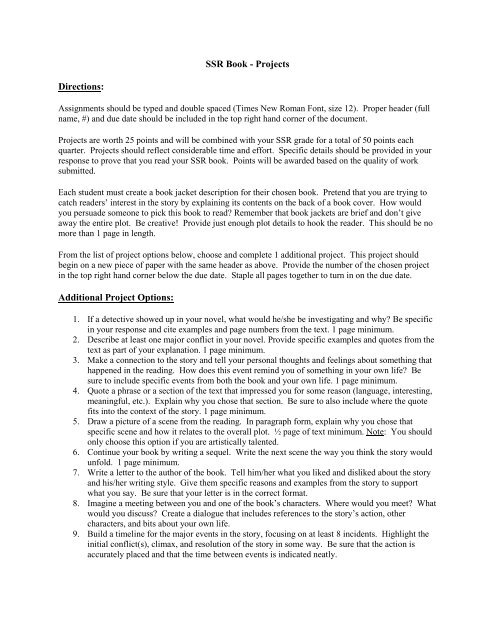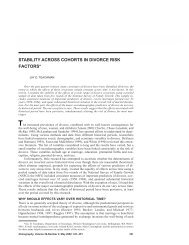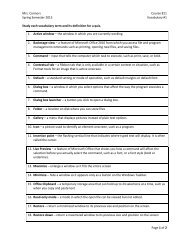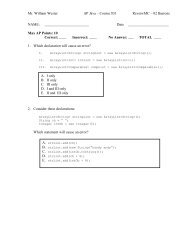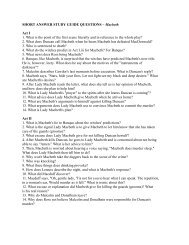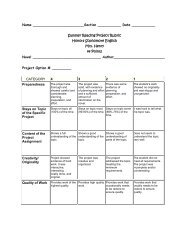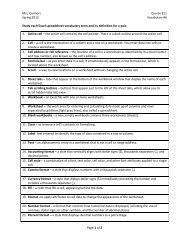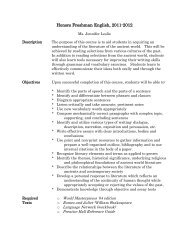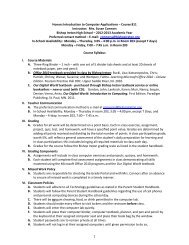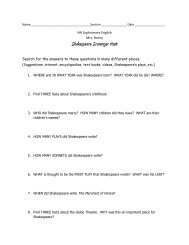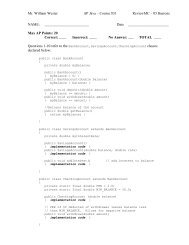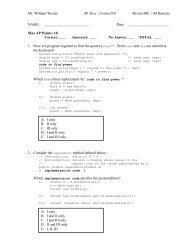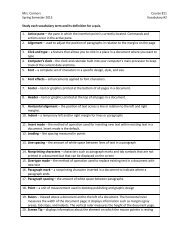SSR Book - Projects Directions: Additional Project Options:
SSR Book - Projects Directions: Additional Project Options:
SSR Book - Projects Directions: Additional Project Options:
You also want an ePaper? Increase the reach of your titles
YUMPU automatically turns print PDFs into web optimized ePapers that Google loves.
<strong>Directions</strong>:<br />
<strong>SSR</strong> <strong>Book</strong> - <strong><strong>Project</strong>s</strong><br />
Assignments should be typed and double spaced (Times New Roman Font, size 12). Proper header (full<br />
name, #) and due date should be included in the top right hand corner of the document.<br />
<strong><strong>Project</strong>s</strong> are worth 25 points and will be combined with your <strong>SSR</strong> grade for a total of 50 points each<br />
quarter. <strong><strong>Project</strong>s</strong> should reflect considerable time and effort. Specific details should be provided in your<br />
response to prove that you read your <strong>SSR</strong> book. Points will be awarded based on the quality of work<br />
submitted.<br />
Each student must create a book jacket description for their chosen book. Pretend that you are trying to<br />
catch readers’ interest in the story by explaining its contents on the back of a book cover. How would<br />
you persuade someone to pick this book to read? Remember that book jackets are brief and don’t give<br />
away the entire plot. Be creative! Provide just enough plot details to hook the reader. This should be no<br />
more than 1 page in length.<br />
From the list of project options below, choose and complete 1 additional project. This project should<br />
begin on a new piece of paper with the same header as above. Provide the number of the chosen project<br />
in the top right hand corner below the due date. Staple all pages together to turn in on the due date.<br />
<strong>Additional</strong> <strong>Project</strong> <strong>Options</strong>:<br />
1. If a detective showed up in your novel, what would he/she be investigating and why? Be specific<br />
in your response and cite examples and page numbers from the text. 1 page minimum.<br />
2. Describe at least one major conflict in your novel. Provide specific examples and quotes from the<br />
text as part of your explanation. 1 page minimum.<br />
3. Make a connection to the story and tell your personal thoughts and feelings about something that<br />
happened in the reading. How does this event remind you of something in your own life? Be<br />
sure to include specific events from both the book and your own life. 1 page minimum.<br />
4. Quote a phrase or a section of the text that impressed you for some reason (language, interesting,<br />
meaningful, etc.). Explain why you chose that section. Be sure to also include where the quote<br />
fits into the context of the story. 1 page minimum.<br />
5. Draw a picture of a scene from the reading. In paragraph form, explain why you chose that<br />
specific scene and how it relates to the overall plot. ½ page of text minimum. Note: You should<br />
only choose this option if you are artistically talented.<br />
6. Continue your book by writing a sequel. Write the next scene the way you think the story would<br />
unfold. 1 page minimum.<br />
7. Write a letter to the author of the book. Tell him/her what you liked and disliked about the story<br />
and his/her writing style. Give them specific reasons and examples from the story to support<br />
what you say. Be sure that your letter is in the correct format.<br />
8. Imagine a meeting between you and one of the book’s characters. Where would you meet? What<br />
would you discuss? Create a dialogue that includes references to the story’s action, other<br />
characters, and bits about your own life.<br />
9. Build a timeline for the major events in the story, focusing on at least 8 incidents. Highlight the<br />
initial conflict(s), climax, and resolution of the story in some way. Be sure that the action is<br />
accurately placed and that the time between events is indicated neatly.
10. Draw a map of where your story took place. It should contain areas where significant events<br />
happened. Use a key to describe these happenings. Be certain to include a title and label the<br />
appropriate areas. Detail, color, and accuracy are points to remember. Note: You should only<br />
choose this option if you are artistically talented.<br />
11. Write an obituary for one of the characters in the book. Follow basic format for an obituary and<br />
include at least 3 complete paragraphs. Use information gathered from the story as well as your<br />
own imagination.<br />
12. Become a character and write a diary with at least 4 entries. Include events from the novel and<br />
share how you feel about them. Write in the voice of the character (using his/her dialect, words,<br />
sayings, etc.). Use typical diary entry format.<br />
13. Write a "Dear Abby" column with questions from at least 2 of the characters in the novel asking<br />
for advice. Their problems/questions should be in keeping with how they were presented in the<br />
book. You must include your solutions/answers as Dear Abby. 1 page minimum.<br />
14. Make a collage of a major theme from the book. Use clippings from magazines, newspapers, etc.<br />
The collage should include at least 6 different clips and should fit on 1 regular sized computer<br />
paper. On a separate piece of paper, explain in one paragraph what theme you are representing<br />
and what it has to do with your novel.<br />
15. Make a tri-fold travel brochure that invites tourists to visit the setting of the book. Describe the<br />
scenery and surroundings. Explain the types of activities that might be available. Your brochure<br />
should employ colorful design, pictures, and phrasing in order to entice travelers to go there.<br />
16. Write a resume of one of your better-detailed characters. Imagine that the character is applying<br />
for a job (appropriate to his/her role in the story). Include objective, prior experience,<br />
education/degrees, hobbies, references, etc. Use basic resume format. Approximately 1 page.<br />
17. Create a comic strip or a storyboard for the events in the story. Be sure that the illustrations and<br />
captions explain the story clearly. Do not include every detail - only those necessary to<br />
understand the actions. Note: You should only choose this option if you are artistically talented.<br />
18. Reflect a part of the story as a creative poem or song. Be sure to include important incidents and<br />
conflicts. Make sure that this poem/song reflects quality time and effort.<br />
19. Discuss an important symbol in the story. Explain why you believe the symbol is important, and<br />
what you believe it is supposed to represent. 1 page minimum.<br />
20. Write a news article covering an event in your story. Include quotes, expert opinions, etc. Be sure<br />
to include who, what, when, where, why, and how. Photo is optional. Approximately 1 page.<br />
21. Research and present information about a particular part of the story: a person, place, event, etc.<br />
Try to discover interesting background or facts not presented in the story. Your resources must<br />
be accurately cited. The presentation may take numerous forms: a written speech, an essay, a<br />
pamphlet, etc. 1 page minimum.<br />
22. Create a twenty-question quiz about your book. The questions should test a reader’s knowledge of<br />
the story and should focus on character, plot, setting, motivation, conflict, and resolution. Please<br />
include the answers to your quiz questions as well.<br />
23. Draft a mock interview with one of your characters. Pretend you are the host of talk show. Create<br />
a list of at least 6 questions (and the character’s responses) to ask your “guest.” The questions<br />
should pertain to the events in the story, but may also search to reveal unknown secrets about the<br />
person (which should keep in line with the integrity of the character).<br />
24. Make a scrapbook about the story or pretend a character had made it about his/her life. This<br />
should look like a real scrapbook, complete with actual memorabilia, awards, letters, photos,<br />
mementos, ticket stubs, report cards, etc. Label each item (at least 8) and explain its significance.<br />
25. Photograph real people, places, and things that represent the same in your novel. Secure at least 6<br />
pictures in an “album.” You may glue the pictures to regular computer paper to create a makeshift<br />
album. For each photo, write a caption that labels the picture and explains how it is connected to<br />
the story.


